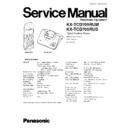Panasonic KX-TCD705RUM / KX-TCD705RUS Service Manual ▷ View online
5.2.5. HOOKSWITCH (SEE Fig. 20)
T8 is the hookswitch, driven by T9. When the phone is “off-hook”, the HOOK control signal from the BBIC will be a high logic level
(+3V), and both transistors will be on, thus T8 will “loop” the line. The zenner diode D10 protects transistors T11 to T13 against
transient line voltages.
(+3V), and both transistors will be on, thus T8 will “loop” the line. The zenner diode D10 protects transistors T11 to T13 against
transient line voltages.
5.2.6. PULSE DIALING (SEE Fig. 20)
During pulse dialing the hookswitch (T8, T9) is used to generate the pulses using the HOOK control signal, which is set high
during pulses. To force the line impedance low during the “pause” intervals between dial pulses, the PULSE-DIAL signal turns
on T11.
during pulses. To force the line impedance low during the “pause” intervals between dial pulses, the PULSE-DIAL signal turns
on T11.
5.2.7. AUDIO CIRCUITS (SEE Fig. 20)
The line output signal from the BBIC RXAF is amplified by T13. The RXAF line is DC coupled to T13 thus making it work as
a current limiter (typically < 8mA). The emitter load of T13 is complex to achieved the correct frequency response, since the line
load is also complex.
a current limiter (typically < 8mA). The emitter load of T13 is complex to achieved the correct frequency response, since the line
load is also complex.
The line input signal TXAF is taken from the junction of R41 and R70.
Phase cancellation of the line output audio occurs at this point, so that only incoming line audio should be passed to the BBIC
on TXAF.
on TXAF.
Circuit Diagram
21
KX-TCD705RUM / KX-TCD705RUS
5.2.8. POWER SUPPLIES (SEE Fig. 21)
The AC adaptor for the KX-TCD705 provides unregulated DC through J2 for the handset charge terminal, the 3.8V regulator
(IC7) and the Relay coil (RL1) when fitted.
(IC7) and the Relay coil (RL1) when fitted.
The 3.8V supply from IC7 is used for the RF module, and is further reduced by T7 to 2.65B for the BBIC supply.
R17, 18 and 28 provide short circuit/over current protection at the handset charge terminal.
Circuit Diagram
22
KX-TCD705RUM / KX-TCD705RUS
5.3. RF MODULE
BLOCK DIAGRAM RF MODULE
5.3.1. RF MODULE (SEE BLOCK DIAGRAM Fig.22)
The RF Module consists of two main components: the PMB6610 transceiver and the PMB6818 power amp.
In the transceiver the 10.368MHz clock signal SYCL is multiplied to around 1.9GHz using PLL (Phase Locked Loop) control.
The TXDA signal is used to control the modulation of this frequency by up to +/- 400 kHz.
Received signals are demodulated, filtered and sent to the BBIC via the RXDA line.
The RSSI (Radio Signal Strength Indicator) signal enables the implementation of diversity switching whereby two antennae can
be mounted in different orientations and their signals compared. The one with better reception can be selected by the BBIC
using the ANT1 and ANT2 lines.
be mounted in different orientations and their signals compared. The one with better reception can be selected by the BBIC
using the ANT1 and ANT2 lines.
23
KX-TCD705RUM / KX-TCD705RUS
6 CIRCUIT OPERATION (HANDSET)
BLOCK DIAGRAM BASEBAND SECTION (HANDSET)
24
KX-TCD705RUM / KX-TCD705RUS
Click on the first or last page to see other KX-TCD705RUM / KX-TCD705RUS service manuals if exist.

